Art, Technology and Trends
The major art schools participate in initiating trends. The Art and Technology Studies department of the School of the Art Institute of Chicago is a leading example. By analyzing significant works by several artists who have carried out studies there, we can begin to understand the range and impact of the practices under consideration and to affirm the excellence of its teaching.

Carlos Fadon Vicente, Vector 10b, 1989.
Since the mid-1970s, Carlos Fadon Vicente has constantly questioned the medium in which he works, ranging from still to moving images, captured or broadcast. Fadon won a Leonardo Pioneer Award in 2018, largely in recognition of the experiments that he started in the department of Art and Technology Studies in 1989, when he seized a color printer at SAIC to produce his series Vectors. Working in total symbiosis with a PaintJet (HP's first color printer) Fadon even accepted printing errors. Further, he incorporated them at a time when computing, in becoming generalized, already symbolized the perfection of images. In a form of letting go, of which serendipity only has the secret, he in a way became the first viewer of a work being produced before his eyes. This makes the Brazilian artist one of the pioneers of what many years later would come to be known as glitch art, a trend that became particularly appreciated by younger generations for whom the extreme perfection of images, controlled in all regards, ends up being boring.
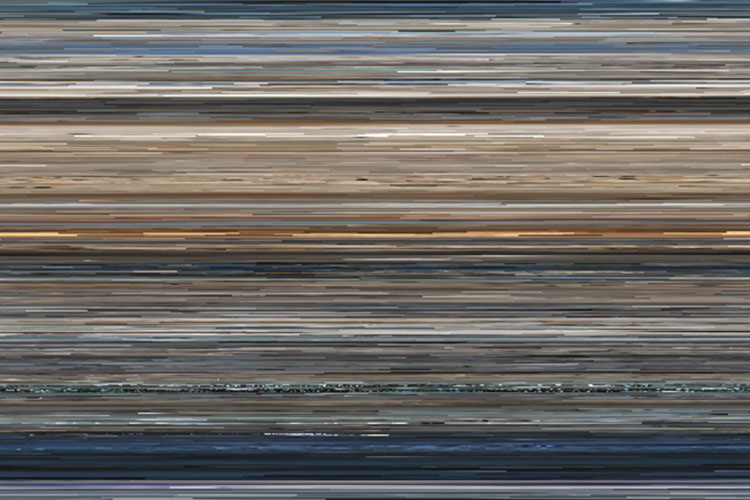
Jason Salavon, The Top Grossing Film of All Time, 1 x 1, 2000.
The works of Jason Salavon, which are included in the collections of the Metropolitan Museum of Art, the Whitney Museum of American Art, and the Art Institute of Chicago are familiar to us. Yet, without their titles they would be, for the most part, pure abstractions. When the artist squeezes every frame of James Cameron’s movie Titanic into a single image, we use our memories of this feature film to distinguish between the light tones of the early sky and the darker ones of the climactic shipwreck. The Top Grossing Film of All Time, 1 x 1 (2000), offers us the visualization of all the hues of this same film through a large number of pixels that, strangely, fit so perfectly, even for those who have not seen the film. With Every Playboy Centerfold, The Decades (normalized) from 2002, it is the body of women and the male gaze that is in question. Salavon merges, decade by decade, the centerfold of a magazine that everyone knows, at least by reputation. Each image is a fusion of 120 bodies—resolutely pictorial representations that evoke imprints, and more precisely that of the Shroud of Turin. In this case, the art lover appreciates the quality of the blurs that translate the depth of the images while the sociologist deciphers the evolution, over time, of the poses or morphologies emerging from the amalgam of codified representations. Through the synthesis and use of data, Jason Salavon offers us distanced interpretations of whole fragments of our popular cultures.
Public space
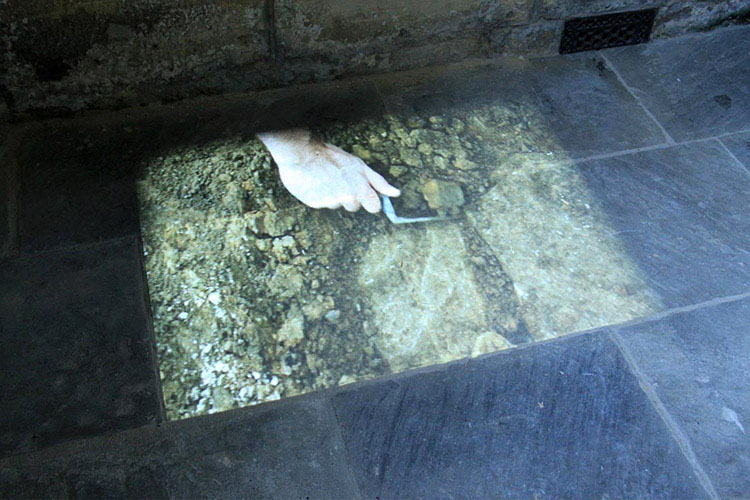
Susan Collins, Excavation, 2012.
The work of Susan Collins is about duration. The duration of processes that allow her, for example, to capture the images from the Seascape (2009) series pixel by pixel, line by line. Her work references the tradition of plein-air painting and the origins of photography. Her seascapes merge temporalities, focusing on luminosities while the scanning inherent in the acquisition process reinforces the extreme horizontality of the points of view. Collins has also dealt with architecture, ranging from the intimate to the monumental. In one example, Excavation (2012), Collins projected a film of an archaeologist digging with a trowel on the floor of the historic All Saints Church in Harewood (United Kingdom). The scene cannot be reliably located in the past or future and, covering just a few slabs, Collins addresses only a handful of privileged spectators. Conversely, Brighter Later (2013), performed at the Radcliffe Observatory in Oxford, addresses the greatest possible number. From sunrise to sunset, her luminous installation informs the surrounding populations about climatic variations including temperature, pressure and rainfall. At a time when each individual responds to the slightest alert from their connected objects, Collins has chosen to create an interface that provides collective observation.
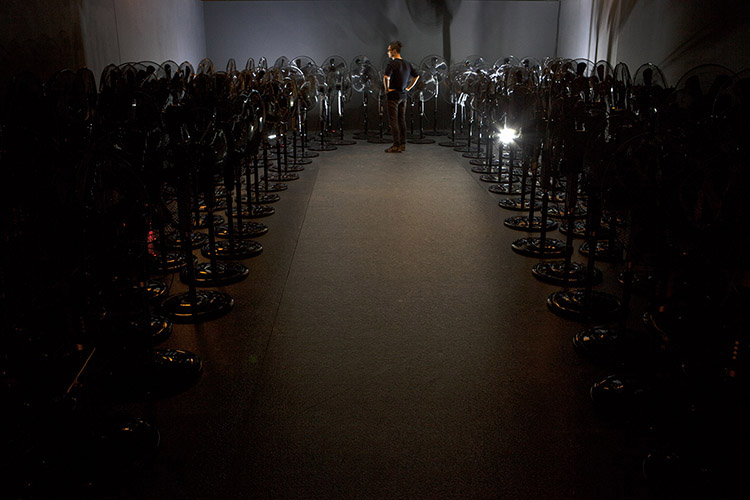
Byeong Sam Jeon, The men with five tongues, 2016.
Even the most mundane objects, creatively assembled and in surprising quantities, are likely to intrigue us. Artist Byeong Sam Jeon reveals the magic that can be found in the objects that fill our daily lives by skillfully multiplying them, as in a 2015 installation in which he covered the facade of an abandoned tobacco factory with nearly 500,000 CDs. The choice of such a support is interesting because it fascinated its users in the 1990s by the amount of data contained. Then, one innovation replacing another, it ended up disappearing from the shelves of our supermarkets— places of accumulation par excellence. But what is interesting about the CD Project is the fact that the CDs were offered by ordinary people, thus confiding some personal data to the artist. No one knows the nature of the data that make up the silver dress of an industrial building where the repeated gestures of the workers of yesteryear still resonate. Beyond the monumentality of Byeong Sam Jeon's installations, there is a symbolic dimension, as is again the case with The men with five tongues (2016). This work brings together, in relative darkness, a hundred fans that the public triggers when approaching. The title of the work encourages us to reconsider the violence of those who are protected by online anonymity within this new agora that is the public space of social media.
Aesthetics of the hybrid
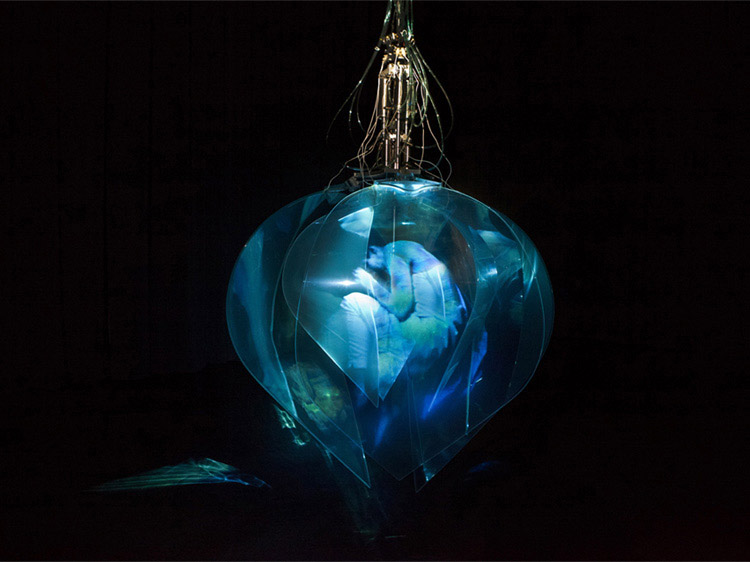
Philomène Longpré, Cereus, Queen of the Night, 2009-2013.
Philomène Longpré’s Cereus, Queen of the Night (2009- 2013) is a hybrid artwork at the crossroads of sculpture, robotics, image, and sound. This makes it, in a way, a total work of art, a concept born with German romanticism in the 19th century and celebrated in the 1950s by the artists affiliated with Black Mountain College. In the center of Cereus, Queen of the Night, there is a woman who performs, and the title of this immersive installation suggests her standing. The video sculpture creates the context of her environment that each viewer interprets in their own way. Formally recalling either a flower or a cocoon, the robotic elements also position it as a technical object. The sculpture protects and, at the same time, encloses the image, making this Queen of the Night the prisoner of the object that allows it to exist. A key element lost in reproductions, the video sculpture Cereus, Queen of the Night reacts to changes in its immediate environment, and the sounds inherent in the mechanized movements of its translucent petals add to the music of the piece when it is played in front of the audience. Cereus, Queen of the Night is an augmented video that exemplifies the expanded cinema theorized by Gene Youngblood as early as 1970, renewing it with the technology of our time.
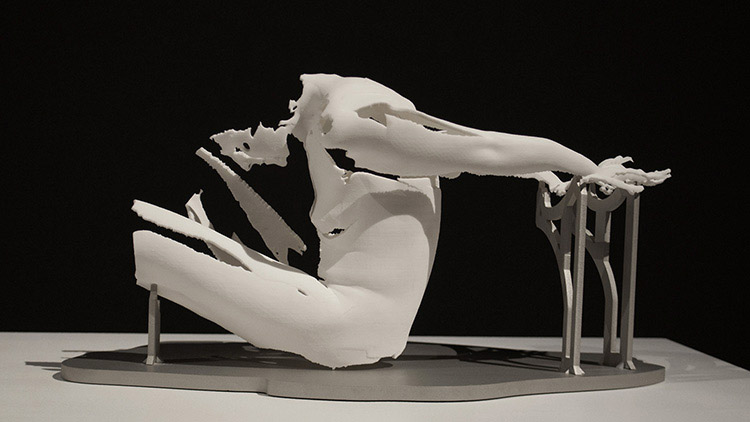
Sophie Kahn, Periode de Clownisme, F, 2014.
Sophie Kahn’s subject of study is the human. She experiments as much with the possible representations of both still and moving images as she does with sculpture. Her favorite tool is a 3D scanner, with which she captures body fragments that are never really immobile. The act of capturing three-dimensional models generally requires poses that once again recall the origins of photography, although Kahn refers more explicitly to the history of radiography. The lack of points, lines, surfaces or matter summon the idea of the unfinished in painting, while the invisible parts of her sculptures correspond to the white or black monochrome backgrounds of her prints or sequences. Though some faces seem to have been burned and limbs mutilated, there is no suggestion of suffering whatsoever. When it comes to whole bodies, they appear to us reassembled, as in natural history museums. Sophie Kahn's work is about capturing life to reveal an element of eternity that lies dormant in each of us. These elements of eternity reveal themselves intermittently, because it is death that gives life its full meaning—a sentiment expressed by past civilizations through the creation of funerary masks, shadow portraits of those whose three-dimensional avatars are eternal.
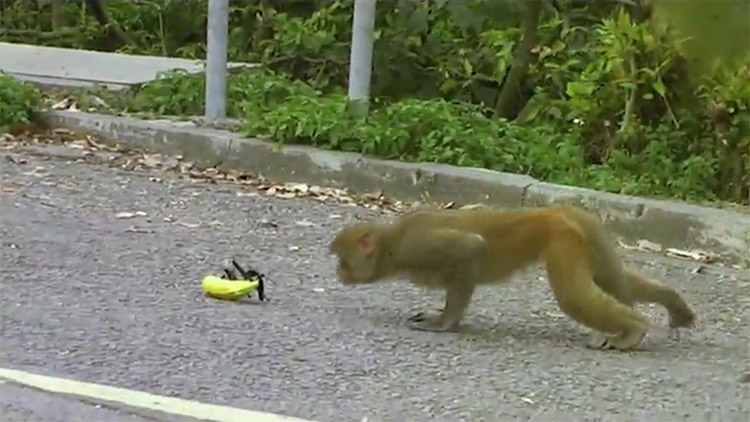
Samuel Adam Swope, Banana Mission; a monkey behavioral study, 2010.
Samuel Adam Swope combines the natural and the technological in a unique way. Most recognized for his aerial art, he constructs and controls aesthetic systems that work with air, and are often themselves airborne. For Swope, aerial art “frames air, giving it a perceptible and systematic volume”. He often creates objects or environments that facilitate novel situations that oscillate between playful and poetic, introducing an uncanny apparatus to challenge cultural constructs, manipulate norms and produce ephemeral spectacles, which are then complemented by skillful documenting and storytelling. This approach is evident in Swope’s technological-natural hybrid Banana ‘copter, a flying banana created for the project Banana Mission; a monkey behavioral study (both 2010). Banana Mission was filmed throughout Hong Kong, from its emergence in the open market to its encounter with feral monkeys at Kam Shan Country Park (also known as Monkey Mountain). Reversing his approach and bringing natural-technological hybrids into the gallery, Ecotone (2017) constructs a narrative around a flying creature, assembled from a mixture of plant and electronic constituents, that is transformed into a ghostly apparition. Each of these works plays with the intersection of technology and the non-human, framing these encounters through an anthropomorphic lens to explore our place within these complex hybrid systems.
Expanded cinema

Joshua Mosley, Jeu de Paume, 2014.
Joshua Mosley is an artist who practices another expanded form of cinema by combining ancient processes from the pre-cinematographic period, such as stop motion, with the most advanced post-production technology. As a director, he produces animated short films whose subjects are unusual. They are often presented as animation loops in contemporary art events, such as the 2014 Whitney Biennial which featured Mosely’s Jeu de Paume. As for the public, it can only let itself be carried away by stories in which the real appears sublimated. We never really know what we are observing as materials ranging from clay to models intermingle with media combining drawing, watercolor and photography with computer graphics. Joshua Mosley is also an artist who leaves clues in his worlds. Clues that disturb our perception of scenarios borrowed from the history of the human sciences. In Dread (2007), for example, French philosophers Jean-Jacques Rousseau and Blaise Pascal discuss the human condition. The artist also details his production process on his website where we can see how his aesthetic depends on the intersection of techniques and technologies.
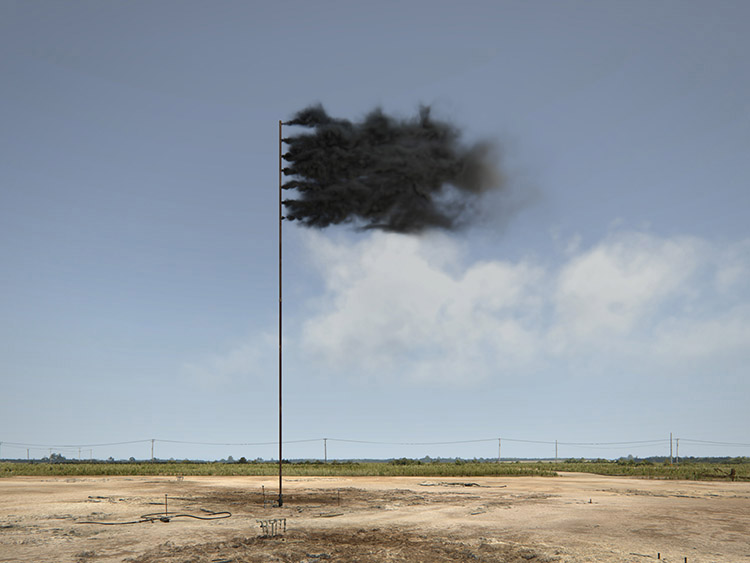
John Gerrard, Western Flag (Spindletop, Texas), 2017.
3D engines are to video games what post-production is to cinema. With their appearance in the 1990s, the general public finally discovered the attractions of immersion combined with interaction. As the power of machines continues to grow, the renditions of these applications have continued to approach a certain idea of reality. During the 2000s, John Gerrard — another graduate of the Art and Technology Studies department at SAIC - focused on the narrative potential of generative simulations. His landscape scenes, without beginning or end, allow contemplation in infinite variations using camera trajectories whose extreme slowness is immediately noticeable as the opposite of the pace of video games, the aesthetics of which the artist readily borrows. In 2009, at the 53rd Venice Biennale, the art world was seized by his large-scale projected video landscapes reminiscent of the American Great Plains region. More recently, Gerrard’s echoes the challenge facing humanity—global warming—by virtually planting his Western Flag (2017) in the Lucas Gusher, in Spindletop, Texas. The work is literally “on Texas time," which symbolized economic development through a natural resource that would change the world: oil. The flag, which usually expresses pride and whose fabric has been replaced by thick black smoke, evokes the end of a world. An end where unbridled consumption can only lead to an announced catastrophe that we still hope we can avoid.
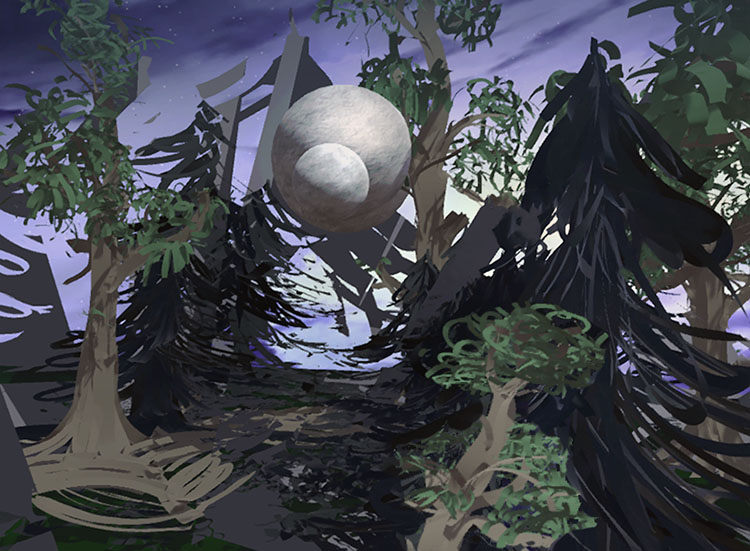
Stephanie Andrews, Ghost Forest, 2016.
Since its origins, cinema has developed in two distinct ways, one of which is more industrial and the other, resolutely experimental. A department dedicated to experimentation with creative technology in an art school must prepare its students simultaneously for such orientations, as distinct as they may be, at least in appearance. Stephanie Andrews works at the boundary between commercial cinema and experimental art. For example, she began as a technical director for some of the most successful animated films, such as A Bug’s Life and Toy Story 2, during the late 1990s. Her latest research has led her to offer audiences virtual reality experiences. Becoming the main actors of Ghost Forest (2016), audiences know that they are in two different places at the same time: in the indoor space where they wear a VR headset and in that of a virtually reconstructed nature that they perceive all around them. With Shards (2017), the experience becomes progressively more complex when the user is immersed in the empty space of a three-dimensional monochrome. During their experience they have the opportunity to observe the fragments of the multiple worlds which virtually surround them. Is the user witnessing a future in which the film industry joins that of video games?
Politics in art
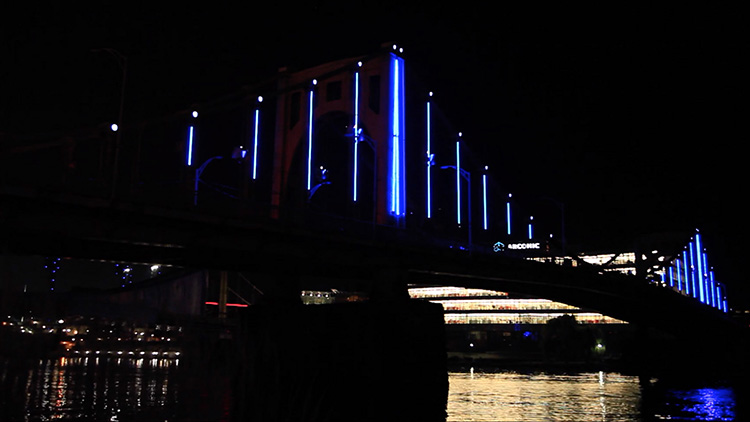
Andrea Polli, Energy Flow (source Jared Rendon Trompak), 2016.
Andrea Polli is an environmental artist who, through her often monumental creations, sounds the alarm. In 2015, Polli’s light installation Particle Falls addressed the world’s most prominent political actors by appropriating the wall of a facade adjoining the Mona Bismarck American Center in Paris. At the same time and in the same city, the 21st United Nations Conference on Climate Change was taking place and we were awaiting important political decisions for universal action on global warming. The projected work represents a cascade of blue water symbolizing purity. But, activated by a nearby sensor, it is transformed into a burst of flames when the air quality indicates an excessive presence of fine particles in the environment. Contemporary threats are invisible or well hidden, and air pollution is one of them. Particle Falls warns us about the quality of the air we breathe while contemplating it. Since 2016, Polli’s Energy Flow has been enhancing Pittsburgh's Rachel Carson Bridge with a myriad of LED lights powered by wind turbines attached to the structure of the bridge. Thus, from sunset to sunrise, the people of Pittsburgh are visually informed of the unseen potential energy of the passing winds. Artists will inevitably have a role to play in the necessary energy transformation that companies, cities or states must initiate without delay all around the world.
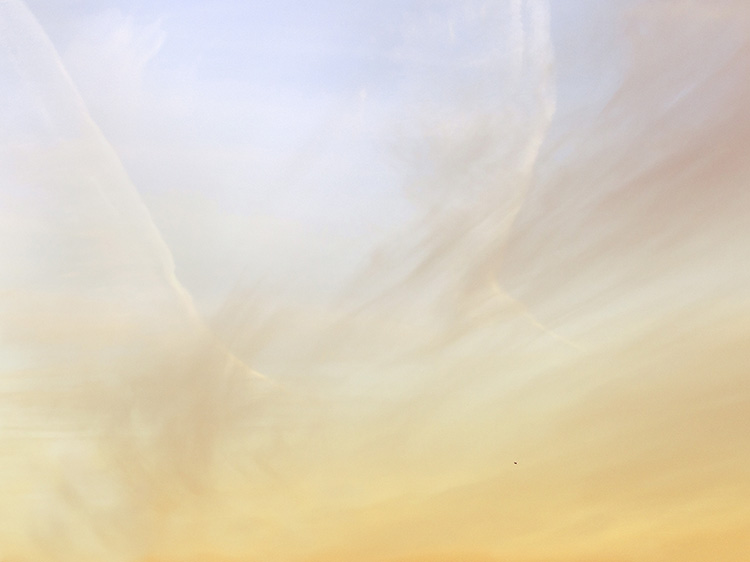
Trevor Paglen, Untitled (Reaper Drone), 2010.
If there is an artist of the invisible it is Trevor Paglen, who uses photography, among other mediums, to reveal what we usually cannot, or do not know how to, see. In the images of his series Limit Telephotography initiated in 2007, the secret military infrastructures that he presents us are less interesting than the blur due to the thick layer of atmosphere, heat and dust that protects them from being seen. The real subject in these same shots is the distance that prevents approaching them. In Untitled (Reaper Drone) from 2010, the subject ‘drone’ can appear to us as a pretext to photograph the morning or evening skies that evoke both the painter William Turner and the photographer Ansel Adams. However, in each of these images there are tiny details informing us of the contemporary threats of constant surveillance or possible strikes. Likewise, the NSA-Tapped Undersea Cables, North Pacific Ocean (2016) remind us of the materiality of the internet network that companies and states share.
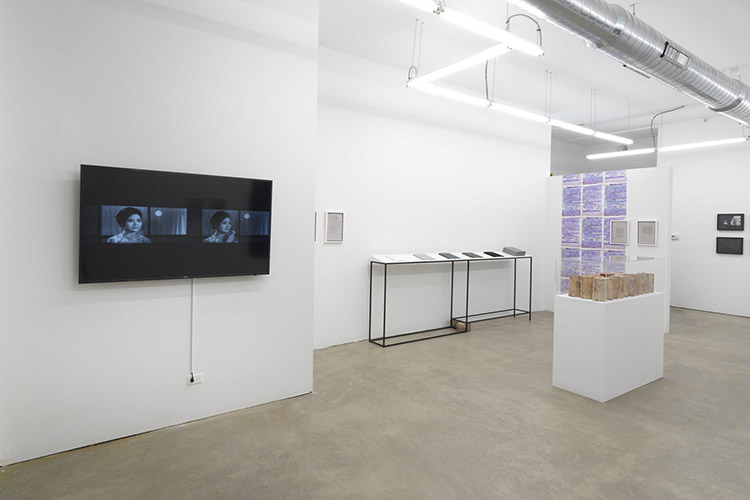
Huong Ngo, Reap the Whirlwind, 2018.
Let's end this non-exhaustive case study with an exhibition of Huong Ngo that brings us back to Chicago in 2018. Her title, Reap the Whirlwind, evokes the idea of consequences to be inflicted, in this case, those relating to the French colonial past in Indochina. Based in Chicago, the artist also works in France and Vietnam, creating works which depict the fragments of a personal story that she assembles with historical events or characters, like Nguyen Thi Minh Khai, a young communist activist who lost her life at the age of 31 in a colonial prison. In Reap the Whirlwind, documentation is essential, exhibited aside other pieces as part of the artwork. The figure of the concubine evoking the relationship of a young Indochinese woman with a French man, possibly one of power, is central. The concubine, in her relation to the colonist who in a certain way she controls, is considered as politically engaged in the artist's books, which draw in the spectator's body. For it is by placing one's hands on the pages of the volumes that the heat temporarily reveals the characters, like so many family secrets that are hard to evoke before forgetting them again. Huong Ngo contributes to an emerging trend in contemporary art that shifts the boundaries between the artwork and its documentation.
What all these artists have in common is that they studied in the department of Art and Technology Studies at the School of the Art Institute of Chicago, which, over the past fifty years, has constantly evolved to best stimulate art students or emerging artists from around the world. They not only continue the research of their predecessors, they initiate new trends in art that uses the technology of their time.
Articles
- Paris Photo
- Art, technology and AI
- Immersive Art
- Chroniques Biennial
- 7th Elektra Biennial
- 60th Venice Biennial
- Endless Variations
- Multitude & Singularity
- Another perspective
- The Fusion of Possibilities
- Persistence & Exploration
- Image 3.0
- BioMedia
- 59th Venice Biennale
- Decision Making
- Intelligence in art
- Ars Electronica 2021
- Art & NFT
- Metamorphosis
- An atypical year
- Real Feelings
- Signal - Espace(s) Réciproque(s)
- On Combinations at Work
- Human Learning
- Attitudes and forms by women
- Ars Electronica 2019
- 58th Venice Biennale
- Art, Technology and Trends
- Art in Brussels
- Plurality Of Digital Practices
- The Chroniques Biennial
- Ars Electronica 2018
- Montreal BIAN 2018
- Art In The Age Of The Internet
- Art Brussels 2018
- At ZKM in Karlsruhe
- Lyon Biennale 2017
- Ars Electronica 2017
- Digital Media at Fresnoy
- Art Basel 2017
- 57th Venice Biennial
- Art Brussels 2017
- Ars Electronica, bits and atoms
- The BIAN Montreal: Automata
- Japan, art and innovation
- Electronic Superhighway
- Lyon Biennale 2015
- Ars Electronica 2015
- Art Basel 2015
- The WRO Biennale
- The 56th Venice Biennale
- TodaysArt, The Hague, 2014
- Ars Electronica 2014
- Basel - Digital in Art
- The BIAN Montreal: Physical/ity
- Berlin, festivals and galleries
- Unpainted Munich
- Lyon biennial and then
- Ars Electronica, Total Recall
- The 55th Venice Biennale
- The Elektra Festival of Montreal
- Digital practices of contemporary art
- Berlin, arts technologies and events
- Sound Art @ ZKM, MAC & 104
- Ars Electronica 2012
- Panorama, the fourteenth
- International Digital Arts Biennial
- ZKM, Transmediale, Ikeda and Bartholl
- The Gaîté Lyrique - a year already
- TodaysArt, Almost Cinema and STRP
- The Ars Electronica Festival in Linz
- 54th Venice Biennial
- Elektra, Montreal, 2011
- Pixelache, Helsinki, 2011
- Transmediale, Berlin, 2011
- The STRP festival of Eindhoven
- Ars Electronica repairs the world
- Festivals in the Île-de-France
- Trends in Art Today
- Emerging artistic practices
- The Angel of History
- The Lyon Biennial
- Ars Electronica, Human Nature
- The Venice Biennial
- Nemo & Co
- From Karlsruhe to Berlin
- Media Art in London
- Youniverse, the Seville Biennial
- Ars Electronica, a new cultural economy
- Social Networks and Sonic Practices
- Skin, Media and Interfaces
- Sparks, Pixels and Festivals
- Digital Art in Belgium
- Image Territories, The Fresnoy
- Ars Electronica, goodbye privacy
- Digital Art in Montreal
- C3, ZKM & V2
- Les arts médiatiques en Allemagne
- Grégory Chatonsky
- Le festival Arborescence 2006
- Sept ans d'Art Outsiders
- Le festival Ars Electronica 2006
- Le festival Sonar 2006
- La performance audiovisuelle
- Le festival Transmediale 2006
- Antoine Schmitt
- Eduardo Kac
- Captations et traitements temps réel
- Maurice Benayoun
- Japon, au pays des médias émergents
- Stéphane Maguet
- Les arts numériques à New York